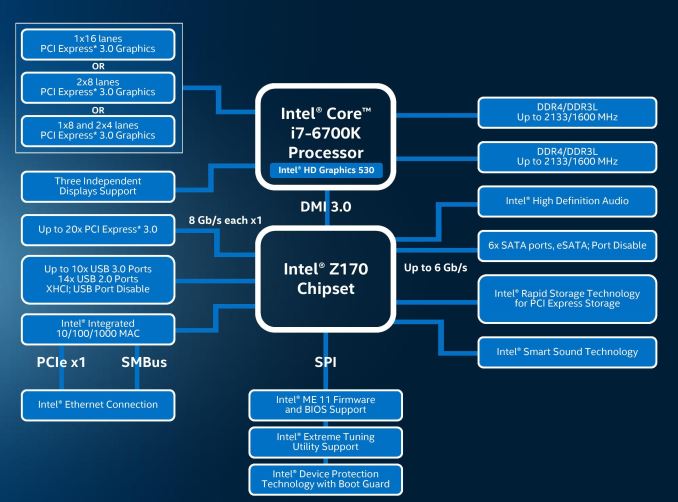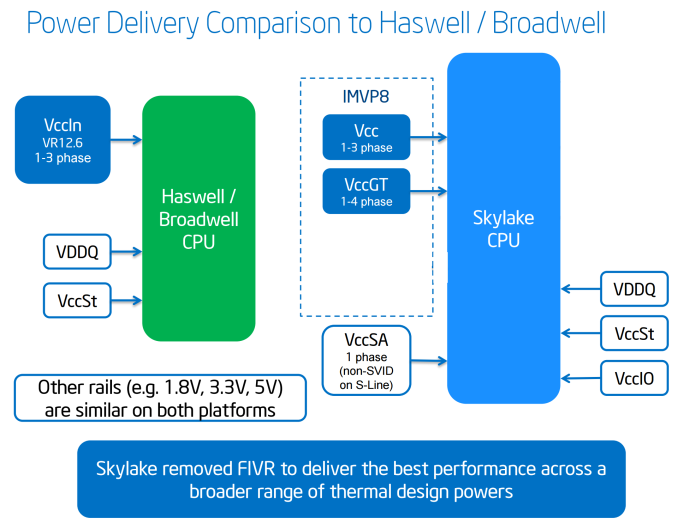The Intel 6th Gen Skylake Review: Core i7-6700K and i5-6600K Tested
by Ian Cutress on August 5, 2015 8:00 AM ESTThe Skylake CPU Architecture
As with any new Intel architecture, the devil is in the details. Previously at AnandTech we have been able to provide deep dives into what exactly is going on in the belly of the beast, although the launch of Skylake has posed a fair share of problems.
Nominally we rely on a certain amount of openness from the processor/SoC manufacturer in providing low level details that we can verify and/or explain. In the past, this information has typically been provided in advance of the launch by way of several meetings/consultations with discussions talking to the engineers. There are some things we can probe, but others are like a black box. The black box nature of some elements, such as Qualcomm’s Adreno graphics, means that it will remain a mystery until Pandora’s box is opened.
In the lead up to the launch of Intel’s Skylake platform, architecture details have been both thin on the ground and thin in the air, even when it comes down to fundamental details about the EU counts of the integrated graphics, or explanations regarding the change in processor naming scheme. In almost all circumstances, we’ve been told to wait until Intel’s Developer Forum in mid-August for the main reason that the launch today is not the full stack Skylake launch, which will take place later in the quarter. Both Ryan and I will be at IDF taking fastidious notes and asking questions for everyone, but at this point in time a good portion of our analysis comes from information provided by sources other than Intel, and while we trust it, we can't fully verify it as we normally would.
As a result, the details on the following few pages have been formed through investigation, discussion and collaboration outside the normal channels, and may be updated as more information is discovered or confirmed. Some of this information is mirrored in our other coverage in order to offer a complete picture in each article as well. After IDF we plan to put together a more detailed architecture piece as a fundamental block in analyzing our end results.
The CPU
As bad as it sounds, the best image of the underlying processor architecture is the block diagram:
From a CPU connectivity standpoint, we discussed the DDR3L/DDR4 dual memory controller design on the previous page so we won’t go over it again here. On the PCI-Express Graphics allocation side, the Skylake processors will have sixteen PCIe 3.0 lanes to use for directly attached devices to the processor, similar to Intel's previous generation processors. These can be split into a single PCIe 3.0 x16, x8/x8 or x8/x4/x4 with basic motherboard design. (Note that this is different to early reports of Skylake having 20 PCIe 3.0 lanes for GPUs. It does not.)
With this, SLI will work up to x8/x8. If a motherboard supports x8/x4/x4 and a PCIe card is placed into that bottom slot, SLI will not work because only one GPU will have eight lanes. NVIDIA requires a minimum of PCIe x8 in order to enable SLI. Crossfire has no such limitation, which makes the possible configurations interesting. Below we discuss that the chipset has 20 (!) PCIe 3.0 lanes to use in five sets of four lanes, and these could be used for graphics cards as well. That means a motherboard can support x8/x8 from the CPU and PCIe 3.0 x4 from the chipset and end up with either dual-SLI or tri-CFX enabled when all the slots are populated.
DMI 3.0
The processor is connected to the chipset by the four-lane DMI 3.0 interface. The DMI 3.0 protocol is an upgrade over the previous generation which used DMI 2.0 – this upgrade boosts the speed from 5.0 GT/s (2GB/sec) to 8.0 GT/s (~3.93GB/sec), essentially upgrading DMI from PCIe 2 to PCIe 3, but requires the motherboard traces between the CPU and chipset to be shorter (7 inches rather than 8 inches) in order to maintain signal speed and integrity. This also allows one of the biggest upgrades to the system, chipset connectivity, as shown below in the HSIO section.
CPU Power Arrangements
Moving on to power arrangements, with Skylake the situation changes as compared to Haswell. Prior to Haswell, voltage regulation was performed by the motherboard and the right voltages were then put into the processor. This was deemed inefficient for power consumption, and for the Haswell/Broadwell processors Intel decided to create a fully integrated voltage regulator (FIVR) in order to reduce motherboard cost and reduce power consumption. This had an unintended side-effect – while it was more efficient (good for mobile platforms), it also acted as a source of heat generation inside the CPU with high frequencies. As a result, overclocking was limited by temperatures and the quality of the FIVR led to a large variation in results. For Skylake on the desktop, the voltage regulation is moved back into the hands of the motherboard manufacturers. This should allow for cooler processors depending on how the silicon works, but it will result in slightly more expensive motherboards.
A slight indication of this will be that some motherboards will go back to having a large amount of multiplexed phases on the motherboard, and it will allow some manufacturers to use this as a differentiating point, although the usefulness of such a design is sometimes questionable.












477 Comments
View All Comments
Sunburn74 - Wednesday, August 5, 2015 - link
Still not budging from my 2600K. There is no evidence of real world benefit of an PCIE drive compared to a sata drive. As for the CPUs, the 25% gain IS impressive considering the short time period it has been accomplished in but is just within the threshold of noticeability. Would prefer to wait till maybe 50% gain or when software really starts to take advantage of SSDs.Pneumothorax - Wednesday, August 5, 2015 - link
You're giving Intel too much slack here. Even the much maligned P4 generations had a 50% improvement in raw speed in 2 years. We've waited almost 4 years for only 25%. What's crazy is it cost Intel billions of R&D for it.heffeque - Wednesday, August 5, 2015 - link
25% in 4 yeas... but their iGPU now has more Dx12 Tier 3 support than nVidia and AMD.Nagorak - Wednesday, August 5, 2015 - link
Unfortunately, no serious gamer will ever use it.Bambooz - Wednesday, August 5, 2015 - link
"in my experience all computers are a bit unstable"in other words: you've been buying shitty components :)
kmmatney - Wednesday, August 5, 2015 - link
OK, come on! You bought a "K" cpu - it's meant to overclock - at least bump it up to 4.2-4.3 Ghz - it will run that without any voltage increase. In fact, most motherboards (mine included) seem to overvolt Devil's Canyon cpus, even at stock voltage. In fact, you can probably undervolt it, and overclock it at the same time, as Anandtech did here:You have a guide handed to you for overclocking this cpu:
http://www.anandtech.com/show/8227/devils-canyon-r...
My Z97 PC-Mate motherbard was setting my i5 4690K at 1.2V while at stock, which is higher than it needs - it can run at 4.5Ghz at that setting!
IUU - Saturday, August 8, 2015 - link
I agree with the upgrading part.But not quite with the 25% IPC increase. 25% is awesome.
Two important things:1. It carries the burden of a useless gpu. It could either consume
less energy or the same with more cores. At least then you would use the cpu
where possible for what it's meant to be used.
2. the 25 % increase is the "real" world performance. Unfortunately the "real" world is terribly
slow to take advantages of the improvement Intel introduces with the new instruction sets.
So while it's good to stay down to earth to the "real" world performance, it would be nice to have also a mention of the theoretical improvements of the cpu.
icebox - Wednesday, August 5, 2015 - link
I still don't see the reason to upgrade from a 2600k even though I really urge to upgrade my hardware :) I really don't care about integrated graphics and I'm pretty sure 80% buyers of i7 k parts don't either.There was no reason when ivy brought 5 percent, haswell another 10% and devil 5% more. Now it's a total of 25%. I want more from a total platform change - I moved from 755 to 1155 for a lot more than that. Mainly I want more than 16 PCI lanes, I understand they'll never give us more than 4 cores because xeon and E series.
euler007 - Wednesday, August 5, 2015 - link
Same here, I'm always waiting every generation upgrade my OC'ed 2500k, but I mainly use my home rig for gaming and these benchmarks give me no reason to upgrade. Maybe Skylake-E.moerg - Wednesday, August 5, 2015 - link
so DDR4 offers nothing in gaming?